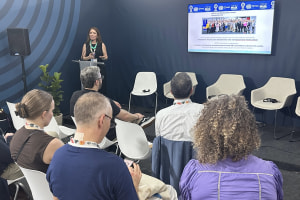In an ongoing conversation about the future of our food system, we often find ourselves caught in a false dichotomy: traditional agriculture versus alternative proteins. This all-or-nothing mindset overlooks what may be the most practical and immediate solution to our food challenges: hybrid products. Nourish Ingredients CEO and founder, James Petrie, writes.
Hybrid foods combine traditional ingredients with alternative ones. New ingredients are unlocking genuine innovation pathways that could transform our food system while addressing the very real challenges of climate change, resource scarcity, and growing global demand.

The quiet revolution already underway
This isn’t about reinventing the wheel. Hybrid foods have always been a practical part of our food system. Traditional sausages, for example, demonstrate the long-standing practice of combining meat with other ingredients to create products that are both appealing and efficient in terms of cost and resources. Our current advancements in food technology and natural fats simply allow us to refine these time-tested combinations, delivering even better results in taste, nutrition, and sustainability.
The hybrid food sector is experiencing strong growth, with products like hybrid meats, milk, and cheese now widely available in supermarkets. Companies are investing heavily in this space and see enormous opportunity in both hybrid meat and dairy.
Think about a bucket of milk and the numerous products it eventually becomes. Sensible hybrid approaches leave most of these pathways intact while adding new, alternative ingredients at critical bottlenecks in the formulation process. This allows the same bucket of milk to satisfy the dairy taste and experience demands of more people, without sacrificing quality. Of course, that last part is not trivial, and this is why we have had to wait for technology to develop before we could address some product categories.
The use of hybrid approaches to upgrade meat quality and make animal supply go further should not be overlooked, but the dairy sector stands as the most promising frontier for hybrid innovation. Demand is rising, with 73% of consumers seeking better plant-based cheese options, according to the Plant Based Foods Association, highlighting major growth potential in this evolving category. We are already seeing consumers embrace products that blend traditional dairy with plant-based ingredients – a transition made easier because many consumers are already familiar with plant-based dairy alternatives.
This hybrid approach helps address what many industry experts have termed “peak milk” challenges. Global dairy demand continues to rise at 2.5% annually, yet traditional production capacity struggles to keep pace sustainably. Hybrid dairy products offer a solution by extending our existing milk supply without increasing animal production intensity.
At Nourish Ingredients, we’ve witnessed firsthand how our specialised fermented fats can enhance both traditional dairy and plant proteins, creating products that deliver the sensory experience consumers expect while reducing environmental impact. Our partners report that hybrid dairy products using our ingredients bring an authentic animal-like sensory experience to their products, which has been lacking, as well as allowing them to displace artificial flavours and ingredients for a cleaner label.
A great example of this in action is our collaboration with dairy leader Fonterra, with a focus on Creamilux – our animal-free lipid that delivers the rich taste, mouthfeel, and emulsification of traditional dairy. By combining our fermentation expertise with Fonterra’s deep dairy knowledge, we’re unlocking functionality across categories like cheese, butter, and even bakery, showing how hybrid innovation can enhance both dairy and non-dairy products without compromising on quality.
Beyond binary thinking
The polarisation that sometimes characterises discussions about our food future serves nobody well. At Nourish Ingredients, we don’t see ourselves competing with traditional agriculture but rather developing complementary solutions that enhance the entire food ecosystem.
This co-design philosophy has resonated strongly with our partners, who recognise that hybrid products offer immediate volume potential while providing financial bottom-line benefits. For investors concerned about the recent slowdown in the plant protein market, hybrid products offer a way to de-risk investments while still moving toward more sustainable food systems.
The future of food isn’t about choosing between tradition and innovation – it’s about thoughtfully integrating the best of both worlds. Hybrid products offer us a bridge to that future, allowing incremental, pragmatic progress rather than waiting for perfect solutions.
By embracing hybrid approaches today, we can make immediate sustainability gains while continuing to develop the technologies that may one day enable fully alternative options at scale. This isn’t a compromise, it’s strategic progress.
As we face the enormous challenge of feeding nearly 10 billion people by 2050 in a climate-challenged world, we need every tool at our disposal. Hybrid foods aren’t just a stepping stone; they’re a crucial component of a diverse, resilient, and sustainable food system that can meet tomorrow’s needs while respecting traditional food cultures and consumer preferences.
Australia has long been a global food innovation leader, from early biotech breakthroughs to world-class agricultural exports. With our strong dairy heritage, robust R&D sector, and growing alternative protein industry, we are uniquely positioned to lead the hybrid food category globally. Through thoughtful innovation and collaboration across the entire food ecosystem, we can build a more sustainable and abundant future, one delicious and healthy hybrid product at a time.






